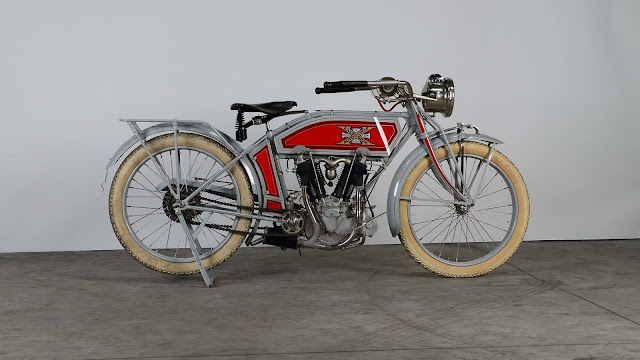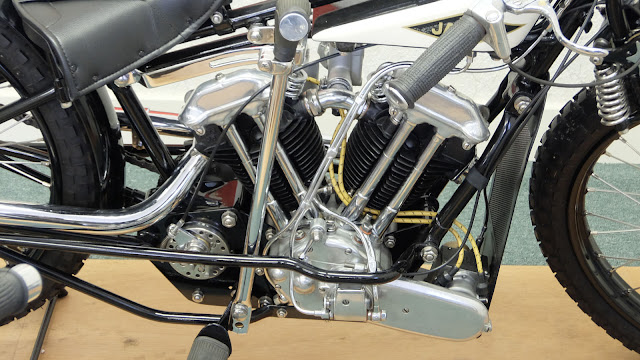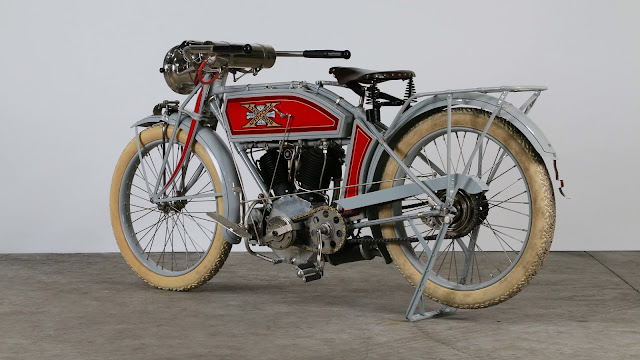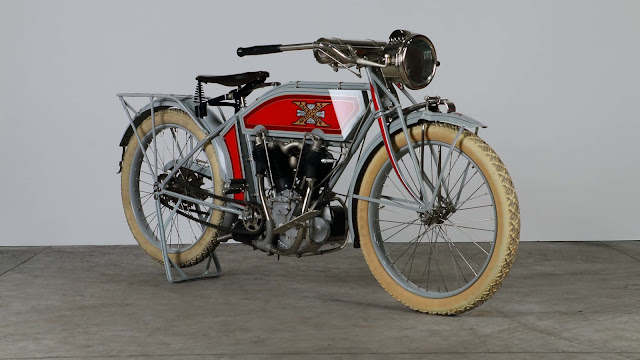Excelsior V-Twin
This 992cc Excelsior dates from 1919 and is finished in the olive paintwork typical of the year. It has a three-speed gearbox, operated by the large lever to the left of the fuel tank, and a foot clutch. The smaller hand lever at the side of the tank adjusts the timing of the magneto ignition.
HOBRI Excelsior was the third of the ‘Big Three’ American marques which early in the last hmKb century were building sophisticated roadsters plus race bikes that often got the better of main rivals Indian and Harley-Davidson. The Excelsior Supply Company began building bikes in Chicago in 1907, with a simple 438cc, 3.25hp single, and three years later introduced an 820cc V- twin model with cylinders spaced at 45 degrees. In 1911, the year that Excelsior was taken over by bicycle maker Ignaz Schwinn, this was followed by a lOOOcc model.
The big Excelsior twin was an impressive machine that was gradually developed in following years. Racing was valuable for development and publicity. Stars including Joe Wolters and Jake de Rosier scored numerous wins on the Chicago-made bikes, and the firm gained publicity in 1913, when Lee Humiston recorded the first official 1 OOmph (161 km/h) lap, at a boardtrack in Los Angeles.
Excelsior’s big V-twin used an F-head (or inlet- over-exhaust) valve layout, and produced about 20bhp; good for a top speed of roughly 80mph (129km/h). Lubrication of the front cylinder was by a pipe leading to its base. This was required because, unlike the rear cylinder, the front one was not sufficiently well lubricated by oil thrown from the crankshaft and conrod assemblies.
Schwinn introduced numerous improvements, notably in 1915 when the twin was restyled and gained a three-speed gearbox. By 1919 the Excelsior typically featured leaf-spring front suspension, sprung saddle, footboards, and olive drab paintwork (a legacy of the First World War). Lights were available at extra cost; some bikes featured twin rear drum brakes but none on the front wheel.
In 1917, Schwinn formed Excelsior-Henderson after buying the Henderson company, manufacturer of sophisticated in-line fours. The firm’s Chicago factory was the largest motorcycle facility in the world, famous for its rooftop test-track. After America entered the First World War, the big factories agreed to refrain from racing. But Excelsior rider Wells Bennett gave the firm a boost with a series of record runs between cities, notably averaging 42.3mph (68km/h) for the 300-mile (483km) desert crossing from Los Angeles to Needles, California in 1918.
Arguably Excelsior’s most famous model was the Super-X, which was launched in 1925 and featured the novelty of a 750cc V-twin powerplant with unit-construction engine and gearbox. Its chassis featured a twin cradle frame and leading- link forks. The light Super-X was immediately competitive against larger-engined rivals in hillclimbing and oval racing, and sparked the rise of 750cc Class C competition when Indian and Harley built ‘45s’ of their own.
In 1929 the Super-X was restyled with Excelsior-Henderson’s ‘Streamline’ look, and was a notably refined machine with a central instrument panel set into its fuel tank. But the Depression of the early 1930s hit sales, as did the growing popularity of cheap cars such as the Model T Ford In 1931 owner Ignaz Schwinn, who was 70 years old, stunned the industry when he abruptly halted motorcycle production and retired.
The V-twin had cylinders spaced at the common 45-degree angle, and F-head valve arrangement. An oil tank below the seat provided front cylinder lubrication.
Brief Revival - The New Super-X
The Excelsior name returned more than 60 years later when brothers Dave and Dan Hanlon bought the name Excelsior-Henderson from the Schwinn company and used it for a V-twin cruiser named the Super-X. The bike incorporated old-style Super-X touches including exposed fork springs, and was powered by a 1386cc, 50-degree V-twin that featured dohc, eight valves and produced 65bhp. Production began in 1999, in a $30 million, purpose- built factory at Belle Plaine, Minnesota. The Super-X was fast for a cruiser, but it was expensive and sold poorly. Excelsior-Henderson ceased production later the same year after only 2000 bikes had been built.
Specification Excelsior V-Twin (1918)
- Engine Air-cooled four-valve inlet-over-exhaust 45-degree V-twin
- Capacity 992cc
- Maximum power 20bhp
- Transmission Three-speed, chain final drive
- Frame Steel single downtube
- Suspension Leaf spring front; rigid rear
- Brakes None front; drum rear
- Weight 500lb (227kg)
- Top speed 80mph (129km/h)



















0 comments: